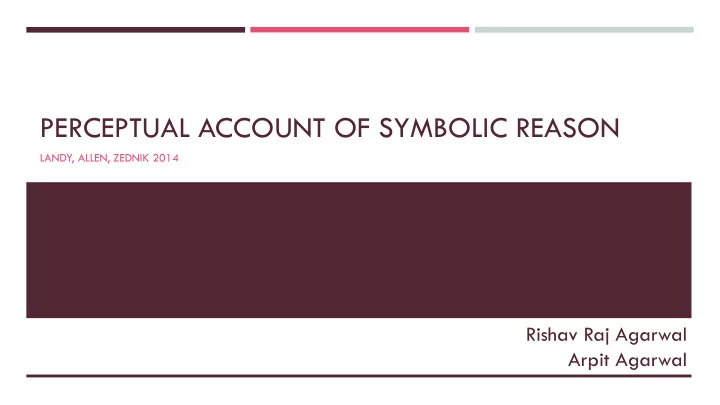

PERCEPTUAL ACCOUNT OF SYMBOLIC REASON LANDY, ALLEN, ZEDNIK 2014 Rishav Raj Agarwal Arpit Agarwal
WHAT IS SYMBOLIC REASONING? The science of reasoning by the aid of representative symbols a+b=b+a
CONTEMPORARY VIEWS Symbolic Reasoning as grounded in the ability to internally represent numbers, logical relationships, and mathemat ical rules in an abstract, amodal fashion.
THE HYPOTHESIS WHAT THE PAPER SUGGESTS
PERCEPTUAL MANIPULATION THEORY Symbolic Reasoning is done by: Complex visual and auditory processes Affordance learning Pattern-matching Grouping of notational structures Role of magnitude and quantity detection systems.
EXPERIMENTS TESTING THE HYPOTHESIS
SOME KEY TERMS Validity Sensitivity Consistency y + 2 = y + 3 - 1 2 * 3 – 4 ¦2 * 3 ¦ - 4 5*X=6*X 2 – 3 * 4 2 * ¦ 3 - 4 ¦
EXPERIMENT 1 Set of 20 questions Time limit Response Time The parameters in focus are orthogonal to other paramers.
DESIGN OF THE EXPERIMENT All expressions will be presented in black text on a white background, using the font glyphicons-halflings-regular on 15.6 inch monitors of resolution 1,366x768 (standard laptop screen). Participants used the keyboard to report validity judgments. The P and Q keys signified valid and invalid judgments, respectively. Though there will be a time constraint, a timer shall run in the background which would capture the response time of the participant with each stimulus.
Letters such as i are avoided. Testing on High School Students and College Students.
AUTHORS’ EXPERIMENT Focused on accuracy Response time not noted Analysis carried out only correct answer.
NOVELTY OF OUR APPROACH Motivation: Reasoning involves System 1. The questions are time limited Response time noted
SUGGESTIONS BY AUTHOR RT’s won’t be sensitive to whether the answer depends on the order of operations Limiting time should be effective in eliminating more sophisticated representations. Mediocre mathematics students get the right answer by reasoning using ‘backup’ strategies, while experts just have better trained visual systems Consider leaving out feedback Leave out the ‘insensitive’ items altogether
EXPERIMENT II See whether people employed motion resources literally under any circumstances. Y X 3 + 2 = 8 Y X 3 = 8 - 2 8−2 Y = 3
REFERENCES
Kirshner, D. (1989). The visual syntax of algebra. J. Res. Math. Educ.20, 274 – 287. doi: 10.2307/749516 Landy, D., and Goldstone, R. L. (2007a). How abstract is symbolic thought? J. Exp. Psychol. Learn. Mem. Cogn.33, 720 – 733. doi: 10.1037/0278-7393.33.4.720 Landy , D., and Goldstone, R. L. (2009). “Pushing symbols,”Proceedings of the 31st Annual Conference of the Cognitive Science Society.Amsterdam Landy, D., and Goldstone, R. L. (2010). How much symbolic manipulation is just symbolic pushing? Landy, D., Allen C., and Zednik, C (2014). perceptual account of Symbolic reason.
Thank You Questions?
Recommend
More recommend